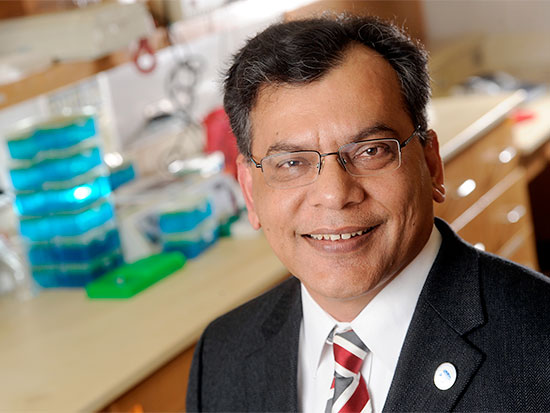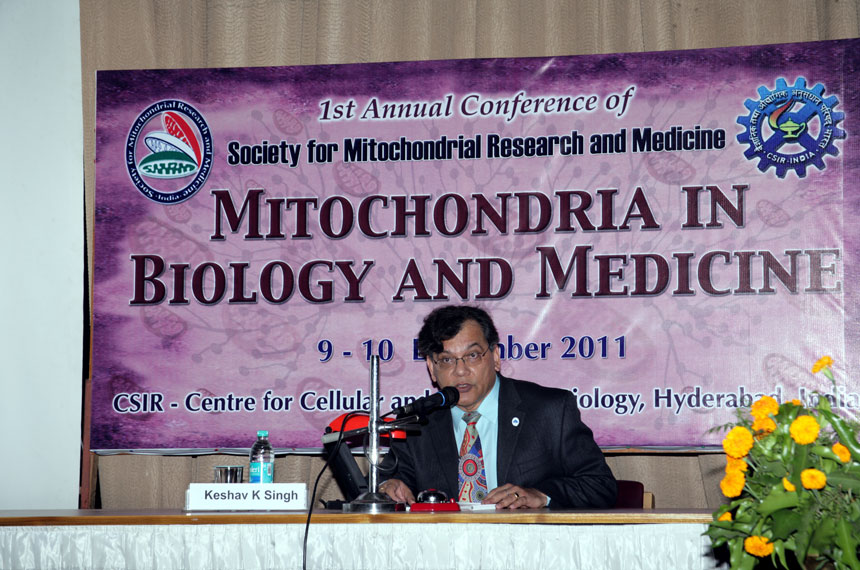(November 25, 2022) In 2018, Dr. Keshav Singh, a professor of genetics at the University of Alabama in Birmingham, was experimenting with mitochondria in mice. The team introduced a mutation to induce dysfunction and, over the next few weeks, observed that the mice developed wrinkles and lost hair – their bodies were ageing. It was an exciting development – if the loss of mitochondrial function led to ageing in mice, could the opposite delay or even prevent it? So Dr. Singh restored the mitochondrial function in the now-wrinkled mice and sure enough, their skin cleared, and the hair grew back. It became the foundation for a startup – Yuva Biosciences.
Global media came knocking and Dr. Keshav Singh, a world leader in mitochondria research. Currently, the Joy and Bill Harbert Endowed Chair and Professor of Genetics, Pathology, and Dermatology at the University of Alabama, Dr. Keshav Singh, the author of three books and over 100 research publications, is on Stanford University’s list of the top two percent of scientists in the world and one of Newsweek’s Innovation Heroes. For over two decades, Dr. Singh has been at the forefront of mitochondrial research, working tirelessly to make a change. He even uses his talent for painting to create artistic renditions of mitochondria on canvas.
In October 2022, Dr. Singh and his team also received a grant from NASA, after a study showed that 57 astronauts suffered from mitochondrial anomalies after their stints at the International Space Station. The organisation has awarded Dr. Keshav a grant to do the animal studies – “We will take our mice and work at the NASA facility in Brookhaven, in a laboratory-created space environment,” he told Global Indian.

Dr Keshav Singh
A long journey
The accolades, although never the end goal, had been a long time coming. Some fifteen years had passed since he started the Society for Mitochondrial Research and Medicine, first in the USA and later on in India, as well as a scientific journal, Mitochondrion, in 2000. At the same time, Dr Singh, along with his young son and daughter, would work late into the night on a companion newsletter, MitoMatters. “My daughter was in charge of the newsletter. We were trying to create awareness.”
“Mitochondria are the powerhouse of the cell,” is biology’s most repeated line, and any Indian student who paid attention in high school can rattle it off without pause. Little is known even today about the complex set of mitochondrial diseases induced due to primary defects in mitochondria. And the information was even scarcer when Dr. Keshav chose it as an area of research. “Nobody cared much for it,” he says. “But one of the godfathers of mitochondria biology happened to be at Johns Hopkins at that time. I was looking for a mentor – when you are an immigrant, moving around all the time, you have no mentor.” Dr. Keshav’s ambitions were thwarted when he was told, “You’re wasting your time. Mitochondria produce energy and there’s nothing more to it.”
Bareilly to Boston
It wasn’t great news, but by this time, well-honed by the education system in India and abroad, Dr. Keshav wasn’t about to give up. He recalls the early days over a Zoom call early on a Saturday morning. “My father was in the railways and I was the youngest child in the family,” he says. “At school, we didn’t get a desk until sixth grade, we had to sit on the floor.” The day the furniture arrived was one of great excitement.
Dr. Keshav excelled in school and in the sixth grade received his first scholarship of Rs 16, a significant sum then. “The first big change came when I did my master’s in GB Pant University of Agriculture and Technology,” he says. After having tried and failed to get a medical seat, Dr. Singh settled on microbiology, which was a top branch of science at the time, with only six seats available across India.
“In college, I used cow dung to make methane, and at the same time, my brother was using methane to make biogas to power a village.” His brother also went on to set up the Ministry of Non-Conventional Sources of Energy.
Fuelled by one academic success after the next, he continued to receive scholarships, at the National Dairy Research Institute, at the Bhabha Atomic Research Centre, and IIT-Delhi, “I was offered scholarships, but the problem I faced was that I didn’t speak English too well, so I joined Central Drug Research Institute in Lucknow for a short while under a CSIR fellowship.”
To foreign shores
He had his degrees but wanted more than to “do mediocre science.” That led him to the University of Wollongong in Australia, where he did a Ph.D. in marine biology and received a scholarship to Woods Hole Marine Biology Laboratories. ” At MBL, I isolated a bacterium from sewage sludge, which was a lot of fun. It turned out it had unique characteristics and hadn’t been discovered before, so I named it after my Professor and me. It grows as a clump but is a single-cell organism.” After a post-doc at Harvard, Dr. Keshav joined Johns Hopkins, where he would remain as a faculty member until 2003.
Mitochondria research
“I learned that hundreds of mitochondrial diseases have no cure or even a name or diagnosis,” Dr Singh remarks. He recalls one case – that of a high-profile patient, the scion of a global hospitality company, who visited Johns Hopkins complaining of a problem in his eye – “he had no energy in the eyelid and a lot of other problems as well,” Dr. Keshav explains. The patient had visited a nephrologist, eye specialist, and neurologist and made no headway with a diagnosis. Mitochondrial diseases are multisystem disorders, so patients end up consulting specialists in those areas without much luck.
Mitochondrial DNA is maternally inherited and passed on to the egg, which contains about five million mitochondria. Each mitochondrion contains 100 copies of the DNA. If even one percent of that DNA is mutated, “you don’t know how it will be distributed in different organs and in which order. That is the dilemma,” Dr. Keshav says. “You may be okay for a while, but if the mutant load increases, you develop symptoms quickly. And even today, there is little or no training in some parts of the world, particularly in India, for physicians to connect these dots and arrive at a diagnosis.”
Work in India
Starting in 2006-07, Dr. Keshav began collaborating with Dr. K. Thangaraj at the Centre for Cellular and Molecular Biology in Hyderabad; Dr. Keshav set up the Society for mitochondrial research and medicine in India. Physicians from America are brought to India to train the physicians here in recognizing symptoms and diagnoses. “There is no treatment, though,” Dr. Keshav admits. For 15 years now, the society has been organising conferences, bringing scientists and physicians together in Bengaluru, Hyderabad, Manipal University, Central Drug Research Institute in Lucknow, and JNU in Delhi.
In the United States, they also involve the patients. Just like the HIV model that was followed in the 1970s and 80s, we bring patients at the end of the conference. The scientists train the physicians, who train the patients, who then go to the politicians and make their case.” Mitochondrial diseases are supported by Democrats and Republicans alike. “There are around 400 diseases related to mitochondria. But, unfortunately, only a handful have been accepted,” he says.

At the first annual conference of the Society for Mitochondria Research and Medicine
Energy for all
Spurred on by the success of the anti-ageing experiment, Dr. Keshav co-founded Yuva Biosciences with serial entrepreneur and fellow Harvard grad Greg Schmergel. Their mission is to “restore mitochondrial function to rejuvenate you, starting with your hair and skin that is provide youthfulness for life.”
The experiment with the mice also received the attention of an MD clinical fellow, Jasmine Chiang, who saw the story in the news. She approached the team at the University of Alabama, asking to work on the ovaries of the mice. “I asked her why an MD and Ob/Gyn who deals with patients would want to do this.” Dr. Chiang, however, was interested in working on the ageing of the ovaries, which takes place at a much faster rate than the rest of the body.
“Mice go through processes which are very similar to that of human beings. When women go through menopause or ovarian ageing, hormones are downregulated, putting them at high risk for cardiovascular, cancer, and neurological disorders. “The idea is to understand how mitochondria control ovarian functions and how we can delay menopause.” Two women in a 100 (amounting to some 60 million women) suffer from premature ovarian aging, a condition for which there is no treatment other than egg donation. Notably, in some countries like Germany, egg donation is prohibited.

Dr Keshav K Singh
‘Fem tech’ and ancient Indian remedies
India, Dr. Keshav says, has much to offer in the area of rejuvenation. “We have concepts like kayakalpa, medicinal plants, and the knowledge of Ayurveda. People talk about regenerating through yoga. At a cellular level, there are technologies in existence that can be utilized and applied along with kayakalpa and yoga to develop ways to rejuvenate mitochondrial function and energy”. Dr. Singh’s goals is to find a way to prevent, restore and rejuvenate mitochondrial function to extend health span and provide energy to all to age well when you get old. He is leading the field to accomplish this goal.
- Follow Dr Keshav Singh on LinkedIn




Congratulations Dear Dr keshav for your contributions to mankind and making all alma matters proud.
Congratulations, Dr. Singh on your achievements and contribution to the mitochondria research.